
by Julia Rosen Tuesday, September 13, 2016
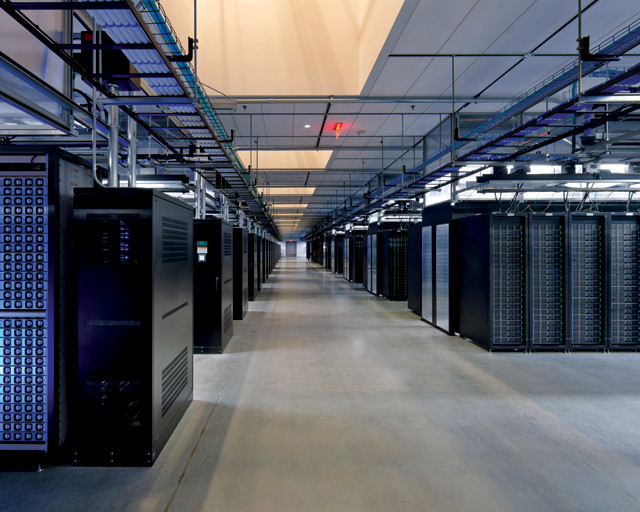
Servers at the Facebook data center in Prineville, Ore., one of the world's most environmentally friendly data centers, use 70 percent less water than Facebook's other data centers. Credit: Facebook, Inc.
Prineville is a sleepy town nestled in the sagebrush desert between the snowy peaks of Cascade volcanoes and the rumpled hills of the Ochoco Mountains. Stunted juniper and shaggy shrubs dot the flat-topped hills that rise above the community of 9,000 people in central Oregon. A narrow ribbon of green — the Crooked River Valley — winds through the parched, buff-colored landscape. It’s striking, but not an obvious place to escape a drought.
Yet California technology companies, like Facebook and Apple, have invested millions of dollars in data centers here over the last five years. A former timber town about two hours from Portland, Prineville is the self-proclaimed “cowboy capital” of Oregon — but it has fast become a high-tech hub too. That’s partly because of tax breaks and cheap energy, but it’s also because the cool, dry climate is ideal for data centers.
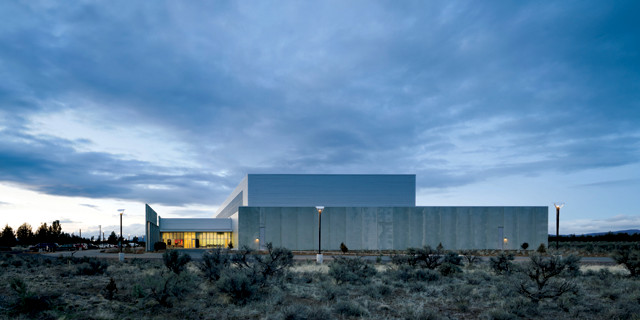
The Facebook data center in Prineville, Ore., was built in an arid grassland and uses cool, dry desert air to help regulate the temperature of its servers. Credit: Facebook, Inc..
These low-slung buildings house the servers that process society’s digital demands. Emails, tweets, credit card transactions — petabytes of data stream through these “server farms” every day. And that requires energy; data centers currently account for about 2 percent of global electricity use. They also require a tremendous amount of water. Servers get hot, and cooling them off has traditionally involved water — hundreds of thousands of liters a day for a medium-sized 15-megawatt data center. And that’s just a fraction of the tech industry’s water footprint. The microchips buried inside every server — and nearly every other electronic device in existence — are also water hogs. Up to 30 liters of water are needed to make a single chip for a laptop or smartphone, and the average semiconductor factory guzzles as much water in a year as a town of 50,000 people. As our seemingly insatiable demand for technology continues to grow, the tech industry’s need for water could become a problem, says Cate Lamb, head of the water program at CDP, a London-based nonprofit that collects information on companies’ climate and water impacts. The world’s freshwater resources are already stressed, and factors like climate change and population growth will only make the situation worse, she says.
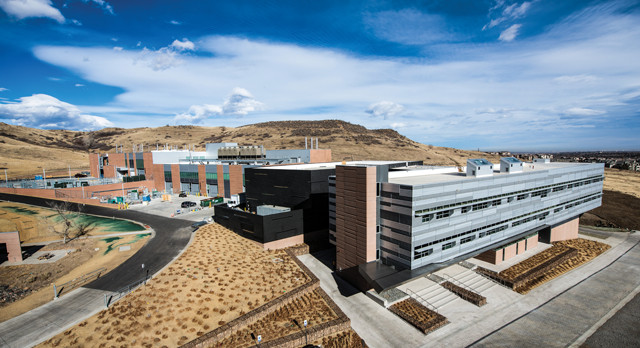
The Energy Systems Integration Facility at the National Renewable Energy Laboratory (NREL) in Golden, Colo., is working to reduce the lab's water footprint. Credit: NREL/Dennis Schroeder.
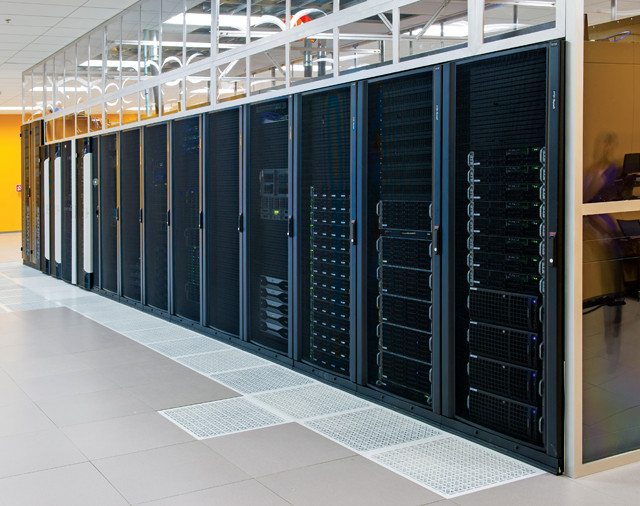
NREL designed a cooling system to harvest heat from the servers to warm office buildings on campus, reducing the amount of heat — and water — shed through evaporation. Credit: NREL/Dennis Schroeder.
The assumption around water is that there will always be a stable supply of good quality freshwater readily available for us wherever and whenever we want it," Lamb says, but growing water scarcity in many parts of the world means that assumption may no longer hold. By 2030, the United Nations estimates that — under a business-as-usual scenario — global water demand will exceed known sources by 40 percent.
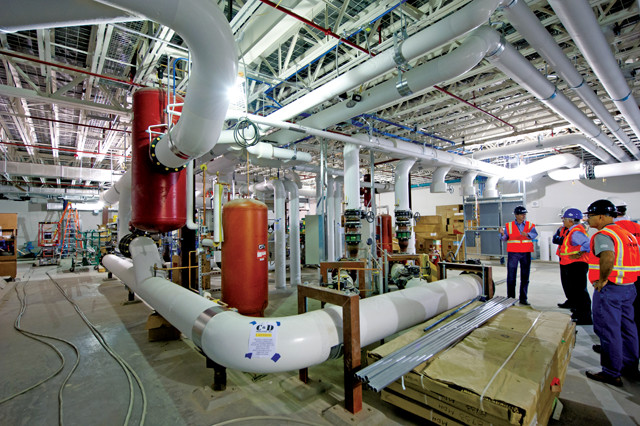
In 2012, Steve Hammond, director of the Computational Science Center at NREL, led a tour during construction of the Energy Systems Integration Facility. Credit: NREL/Dennis Schroeder.
That’s why tech companies are working to reduce their water consumption. And they are doing it the way they know best: through innovation. And that’s one reason some ended up in Prineville.
Facebook’s complex of data centers overlooks the town from a plateau to the west. The buildings are large and plain, except for the entrances. There, visitors must pass through a row of vertical cement towers that evoke the stacks of servers whirring inside. When the first facility opened in 2011, the company boasted that it was one of the most environmentally friendly data centers on the planet. It uses about 40 percent less energy than Facebook’s other data centers, and 70 percent less water, according to company statements. The Prineville data center was also the first to publicly report its water-use efficiency. Anyone with an internet connection can see how the center is performing at any moment. Currently, it averages 0.25 liters of water per kilowatt-hour of energy consumed, about a quarter of conventional facilities. One key to Facebook’s success has been to rethink its cooling strategy. Traditional methods, based on technology similar to air conditioners, use pipes filled with chilled water to draw heat away from servers. That heat is then transferred to cooling towers, where it is removed through evaporation, the same way that sweating cools skin. Much of the water returns to the cooling system, but some fraction is lost in each cycle, and that adds up to millions of liters per year. “We use a staggering amount of water,” says Jack Pouchet, vice president of market development for Emerson Network Power and a board member of the Green Grid, a nonprofit organization based in Beaverton, Ore., that strives to make data centers more sustainable. The National Security Administration’s sprawling data center in Bluffdale, Utah, for example, reportedly uses 6.4 million liters per day — the equivalent of two and a half Olympic swimming pools. Dry cooling technologies do exist, but they often demand more energy.
In Prineville, Facebook has developed a more efficient evaporative cooling system, and tries to minimize the amount of time the system operates by using the cool outside air as much as possible. In a blog post for the Open Compute Project — an effort by Facebook to share efficient data center designs — the company likened the approach to putting a fan in the window rather than running the air conditioner. This technique, known as free cooling, has become increasingly common in new data centers.
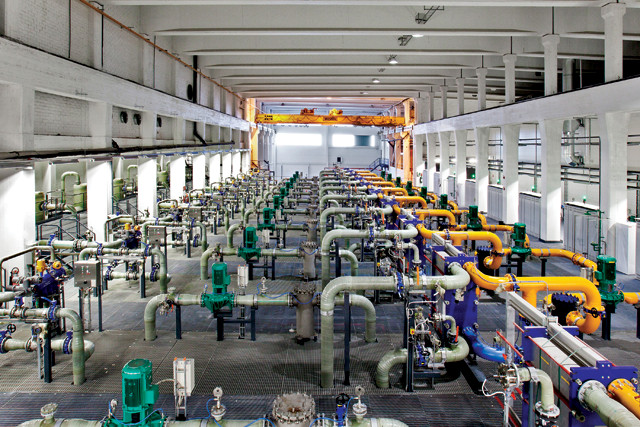
Google's cooling plants in Hamina, Finland, use water from the Gulf of Finland to cool the data center. Credit: Google, Inc..
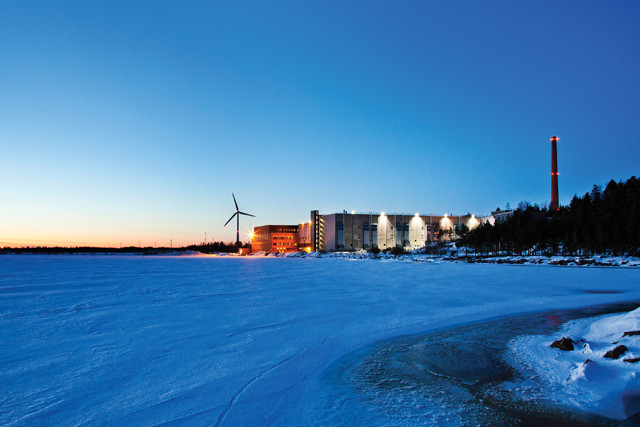
Google's cooling plant in Hamina, Finland. Credit: Google, Inc..
That’s just one solution to the problem; other companies are aggressively seeking their own solutions. Apple, which just announced plans to construct a third data center in Prineville, will also build a wastewater treatment plant so that it can cool its facility with recycled sewage. Google has established a data center in Hamina, Finland, that uses seawater. And Microsoft has been experimenting with placing pods of servers underwater, which would allow them to position servers close to major population centers and essentially eliminate the need for active cooling.
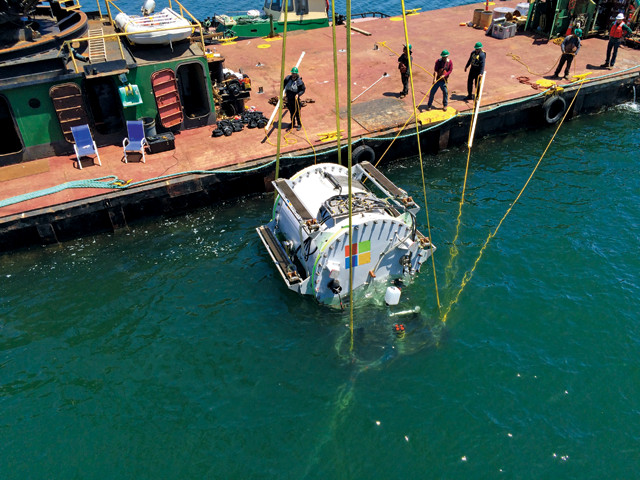
Microsoft has been experimenting with placing pods of servers underwater off the U.S. West Coast, which would allow the company to position servers close to major population centers and essentially eliminate the need for active cooling. Credit: Microsoft Corp.
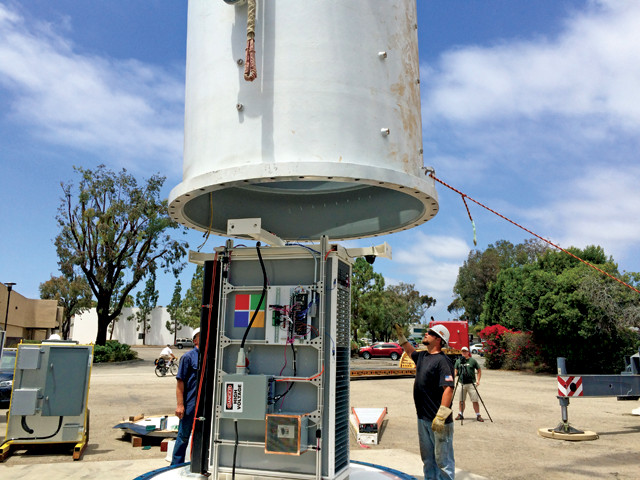
Microsoft server pod testing. Credit: Microsoft Corp.
The national labs are getting on board too. David Martinez, engineer project lead for infrastructure computing services at the Department of Energy’s (DOE) Sandia National Laboratories, has been working with DOE’s National Renewable Energy Laboratory (NREL) in Golden, Colo., to reduce the water footprint of NREL’s data center. During the first phase of their partnership, they designed the cooling system to harvest heat from the servers to warm office buildings on campus, reducing the amount of heat — and water — shed through evaporation. They also have liquid-cooled servers that use specially treated water that cool them more efficiently than air.
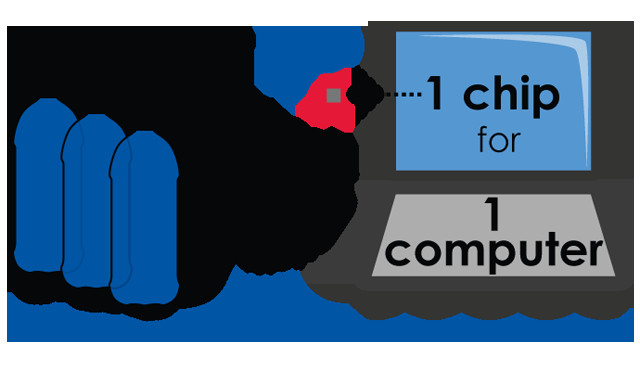
30 liters of water are needed to make one chip for one computer. Credit: K. Cantner/AGI.
This spring, Martinez’s team and the NREL team connected the data center’s chilled water system to a “hybrid” cooling tower that doesn’t use evaporation. Instead, heat is released by vaporizing and condensing a refrigerant inside a closed loop — a technique that also works well in places like Colorado, where cool outside air can be used to dissipate heat from the refrigerant coils during much of the year. A similar system had been used before in power plants, Martinez says. “It wasn’t thought of to use in data centers until we started talking about the extreme heats that we are going to be facing and looking for water conservation.” The team started testing the technique this past summer. Martinez says it should reduce water consumption by more than 40 percent, and could serve as a model for other centers.
Not all data centers can relocate to places with ideal climates or plenty of nonpotable water resources like treated sewage. Some must be located near population centers, says Shaolei Ren, an electrical and computer engineer at the University of California, Riverside. Especially with the explosion of smart devices and a growing reliance on cloud computing, society now generates too much data to ship it all off to remote locations. “That would be a disaster for the internet because the internet has limited capacity,” Ren says. The solution, he says is “to build a lot of distributed data centers everywhere, even in those places that are not so water efficient.”
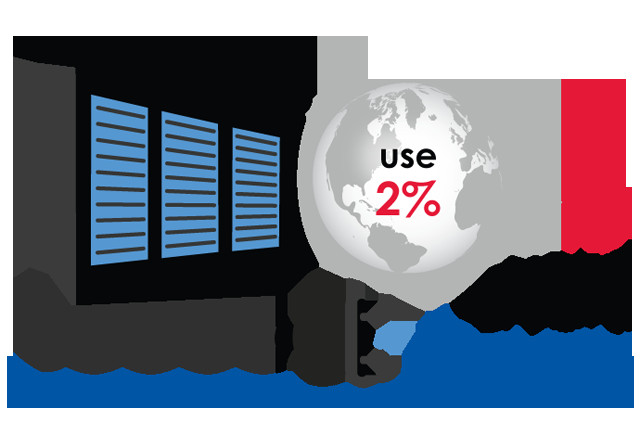
Data centers use 2% of global electricity. Credit: K. Cantner/AGI.
In many spots — like downtown Los Angeles — outside air cooling isn’t an option, and server farms must compete for limited supplies of reclaimed water. Unlike tech giants that can build their own wastewater treatment plants, many smaller corporate data centers must rely on municipalities. In the San Francisco Bay Area, for instance, although there is plenty of recycled water to go around, problems with water quality and the high cost of connecting to the so-called “purple pipe” — which carries reused water — can be prohibitive for some companies, says Cindy Clark, chief development officer at the nonprofit Sustainable Silicon Valley in Santa Clara, Calif., and founder of its water-reuse project.
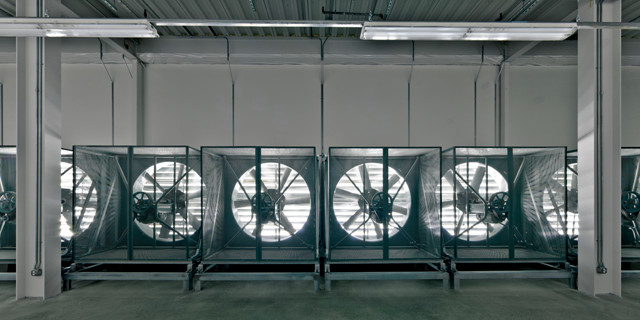
Installation of massive fans to keep servers and other equipment from overheating, known as free cooling, has become increasingly common in new data centers. Credit: Facebook, Inc.
While new waterless cooling systems are being developed, many companies are searching for other strategies to reduce water use at data centers. One way to do that is to cut down on energy use. This both lowers the amount of water indirectly consumed in producing electricity, which often accounts for a big fraction of a center’s total footprint, and results in less heat being generated inside the facility. “It’s a chain reaction,” Martinez says. Reducing energy use can involve steps as simple as installing partitions that prevent hot exhaust air from mingling with the cold air coming in to cool servers, says Pouchet of Emerson Network Power. Decommissioning useless “zombie servers” — those that consume electricity, but that don’t function properly or serve a purpose — and upgrading to more efficient modern equipment can also have a huge impact, Pouchet says.
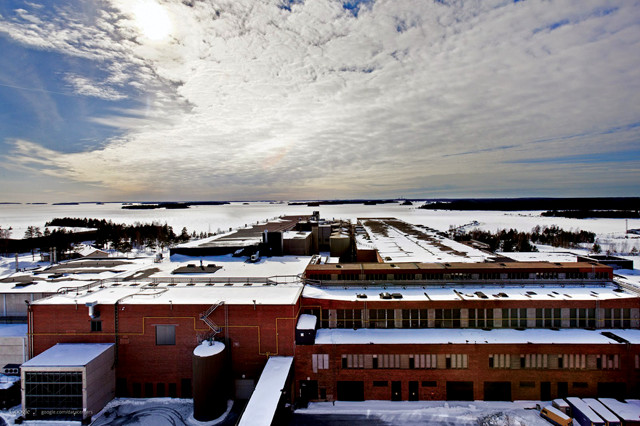
In Hamina, Finland, Google renovated an old paper mill into a data center, which draws water from the sea to cool servers. Credit: Google, Inc.
However, changes like these require money, and may be out of reach for many data centers, Ren says. That’s why he’s been working on a cheap solution: using software to schedule workloads in ways that optimize water use. It works by splitting a data center’s tasks into two kinds of jobs. The first includes user requests like web searches and updates to smart devices, which must be dealt with right away. But the second category of processes — such as analyses of user activities that get reported back to tech companies — can easily be delayed by a few hours without disrupting operations. Ren’s software postpones this work until the evening, when the air temperature has cooled and evaporation sheds heat more efficiently. As a result, the data center can complete the same amount of work using less water. Similarly, if a company has many data centers spread across various locations, it could funnel jobs to the most efficient place. “The server system is really intelligent,” Ren says. “This gives us a control knob so that we can shift workloads to places that are more water efficient.” His calculations show that these measures could boost water efficiency by as much as 60 percent. However, despite the high-profile efforts of tech giants like Facebook, industrywide progress has been slow. A recent survey by the Uptime Institute, an independent advisory organization for the tech industry based in Seattle, found that most data center operators view water as a low priority and that fewer than 30 percent even track their water-use efficiency. Multitenant data centers pose a particular challenge, Pouchet says. The companies that use them don’t control the facilities, and for many of them, servers are a necessity but not a focus of their business, making data center water use a secondary issue. Extreme events like the drought in California could help change that sooner rather than later. The California Energy Commission recently began offering incentives to data centers that use waterless cooling systems. But even in the absence of such incentives, Pouchet says he’s optimistic. “It’s carrot-and-stick, but we are going to get there.” Leaders like Facebook, Apple and Microsoft have already shown that it’s possible to make huge gains in water efficiency, and expansions in the developing world, where reliable water sources are scarce, have led to even more creative solutions. “I think it’s a problem that is slowly solving itself,” he says.
The specter of water scarcity looms even larger over the semiconductor industry. Semiconductor chips act as the brains of computers, phones, cars and innumerable other devices, but producing them requires huge amounts of water. According to Ceres, a sustainability organization based in Boston, the average semiconductor factory uses up to 15 million liters of water per day — more than many data centers consume in an entire year.
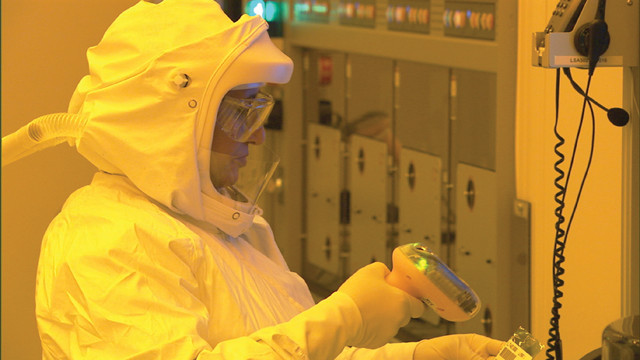
The semiconductor industry requires ultrapure water (and ultra-clean rooms). It used to take almost two liters of tap water to produce one liter of ultrapure water, but Intel has reduced the ratio to 1.1 to 1. Credit: Intel Corporation.
Like data centers, semiconductor fabrication facilities — known as “fabs” — use water for cooling, as well as for common uses like irrigation and plumbing. But the majority of their water footprint stems from their demand for ultrapure water used in manufacturing. Making semiconductors involves depositing numerous layers of conducting and insulating materials, and etching patterns into them to create circuits. Of the hundreds of steps involved, many rely on chemical reactions that take place in water, or that require thorough rinsing before and after. Because of the complexity of microchips, this water must be exceptionally clean. As the semiconductor industry has kept pace with Moore’s Law — which predicts that the number of transistors crammed into a chip will double every two years — the architecture of modern chips has shrunk beyond microscopic. The holes and trenches that conduct electricity now span only a few nanometers. Even a few tiny contaminants in the water can completely destroy the circuits, says Manish Keswani, a chemical engineer at the University of Arizona.
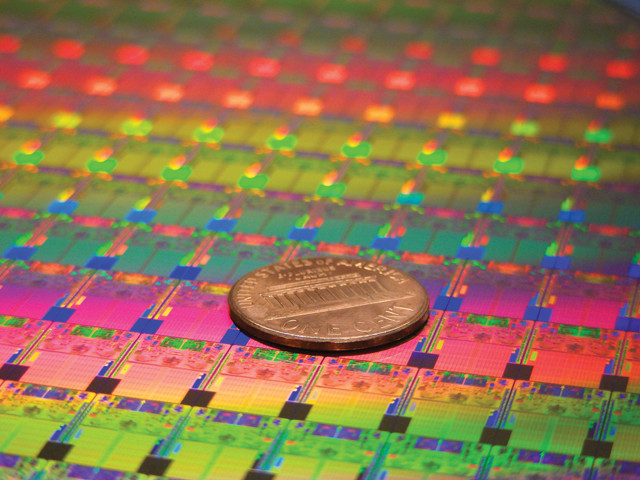
As the architecture of modern chips has shrunk beyond microscopic, even tiny contaminants in the water used to produce them could destroy the circuits. Credit: Intel Corporation.
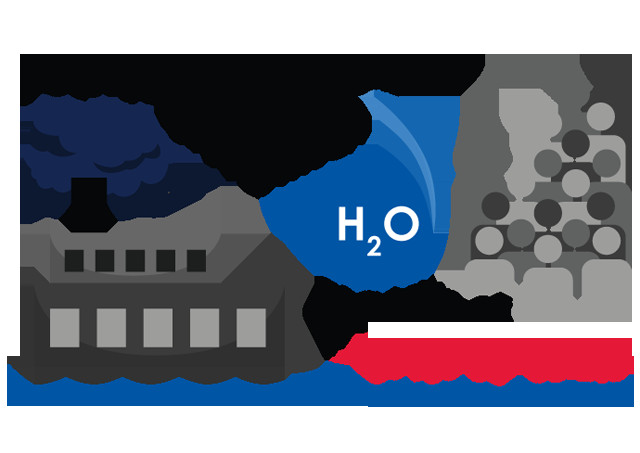
One semiconductor lab uses as much water as a town of 50,000 people. Credit: K. Cantner/AGI.
Keswani hopes the university’s latest innovation will have better luck. It’s a way of using high-frequency sound waves to knock particles loose, allowing manufacturers to clean wafers without using chemicals that must be rinsed away. Many companies already use a version of this technique called megasonic cleaning. However, as the features of microchips have gotten smaller and smaller, subjecting them to these frequencies has started damaging them.
Keswani has tweaked the approach by using a combination of frequencies, or a single frequency in conjunction with electrochemistry, which appear to limit the destructive effects of the tiny bubbles formed by sound waves that actually do the cleaning. He published the details of these techniques earlier this year, and says it’s too early to gauge their reception. However, he thinks manufacturers will be interested in any water-saving strategies they can use. The industry spends an estimated billion dollars a year on water management. “They would love to have a technology that can save some water,” he says.
Despite these gains, however, water use in the semiconductor industry is projected to increase as technology gets more sophisticated. In a recent Corporate Responsibility Report, Intel noted that the more complex its chips become — as it builds features that resemble tall, densely packed skyscrapers instead of sprawling suburban neighborhoods — the more water it will use. Experts also predict that a coming shift toward bigger wafers will also drive up water consumption.
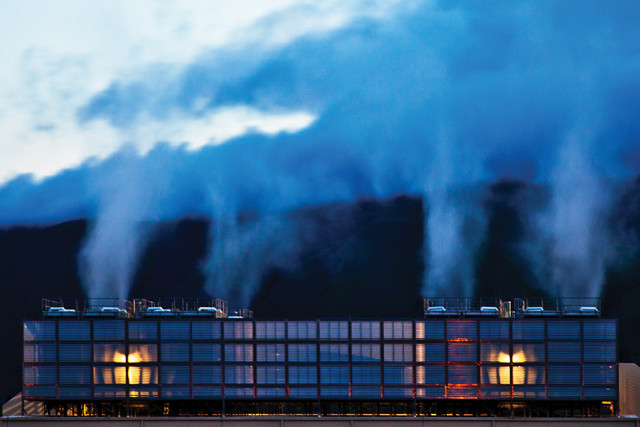
Water vapor vents from Google's data center in The Dalles, Ore. Credit: Google, Inc..
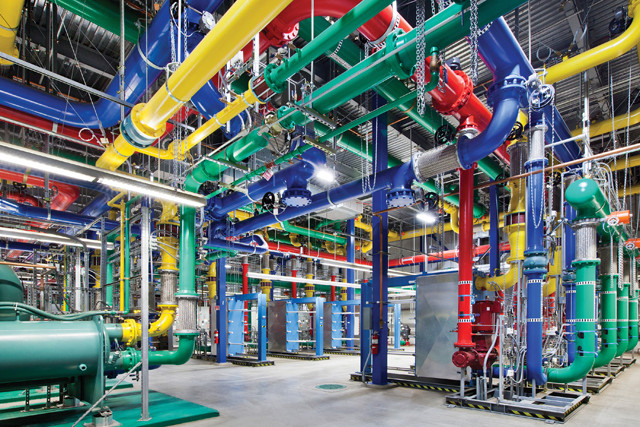
Inside, blue pipes carry cold water into the facility and red pipes return warm water to be cooled. According to the Google website, the location was chosen "for its mild climate and access to hydroelectric power." Credit: Google, Inc.
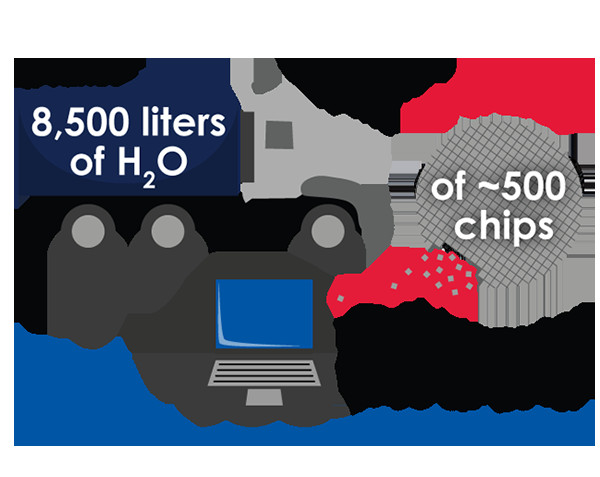
It takes 8,500 liters of water to make 1 wafer of about 500 chips, with 1 chip to be used for each computer. Credit: K. Cantner/AGI.
One is Ovivo, based in Montreal, Canada. It has developed a method involving bacterial strains that are capable of digesting hard-to-remove organics while withstanding the harsh oxidizing conditions of the wastewater. These bacteria will help companies to recycle up to 85 percent of their ultrapure water, says David Harris, Ovivo’s general manager of electronics and metals for the U.S. “We just finished a pilot system this last year where we’re taking the worst of [a company’s] wastewater and we’re cleaning it up to a very high level of purity cheaper than they can buy city water,” he says.
Some semiconductor plants in the U.S. already recycle and reuse 50 to 70 percent of their manufacturing water, Harris says. Drought provided part of the motivation to push that number higher at Ovivo’s pilot project in Texas, and even more is possible, Harris says. It all depends on money. “As the water becomes more scarce, the cost of that water goes up, and that’s what opens the door for applying different technologies to get higher recovery,” he says. In other countries, where water prices and regulations differ, companies have already made greater progress. In Japan, for instance, many fabs produce virtually no wastewater at all.
Recycling also has other benefits for manufacturers, like ensuring a reliable water supply. This can help companies weather interruptions in municipal water sources and make the quality of the water more consistent. In some parts of the U.S., like upstate New York, manufacturers have to cope with seasonal changes in city water that stem from changing weather patterns and agricultural activities. With recycling, factories always know what they’re getting.
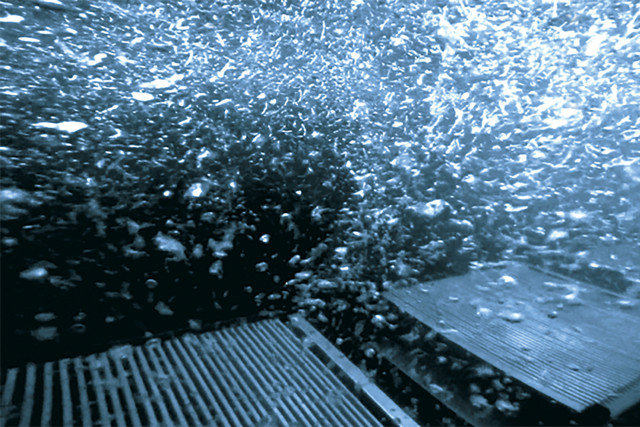
Ovivo is testing several ways to help companies reclaim wastewater at semiconductor production facilities. These Ovivo submerged filter systems contain stacks of modules, each with multiple silicon carbide membranes that are chemically resistant and long lasting. Credit: Ovivo USA LLC.
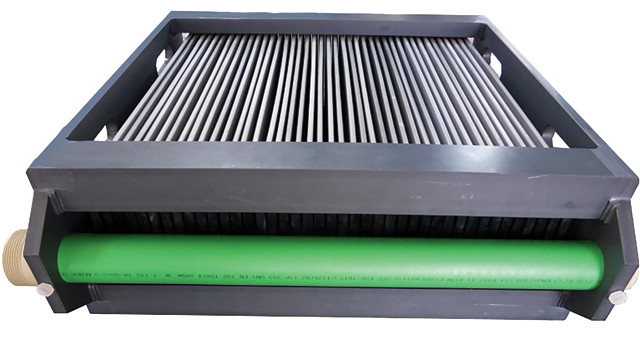
An Ovivo submerged filter system. Credit: Ovivo USA LLC.
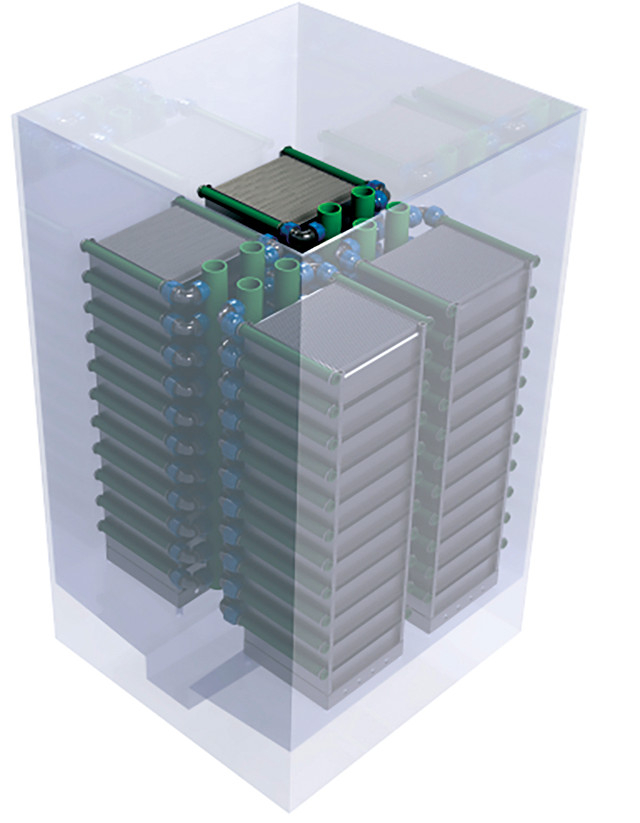
An Ovivo submerged filter system. Credit: Ovivo USA LLC.
Not all wastewater can be purified enough to reuse in chip manufacturing. But many companies are finding other uses for less pure water to offset their overall water withdrawals. For instance, the water can be used for cooling towers or landscaping. These techniques have also spread to corporate offices in Silicon Valley and beyond, says Clark of Sustainable Silicon Valley. “They have amazing water conservation and water efficiency efforts on their campuses.”
Taken together, are these measures enough to buffer the tech industry from increasing water scarcity? It’s hard to say, says Lamb of CDP. “Many companies still today are undertaking seriously inadequate water-related risk assessments,” she says. “Many of them still don’t know where their water comes from, let alone who else might be relying upon that water and how that demand may shift.”
Although water availability is a global issue, it is also an intensely local one. Companies depend on the rivers and aquifers that supply water in the places they operate. And even though tech companies don’t use nearly as much water as agriculture, they are often the biggest consumers in their districts. So their fates are inextricably linked to the health of their watersheds, Lamb says.
But in many places where tech companies have set up shop, the future of these watersheds is uncertain. Data centers are springing up in deserts, and semiconductor factories can be found throughout water-stressed regions. Eleven of the 14 largest fabs are located in the Asia Pacific region — where demand for electronic devices is high but where the industry must compete with booming populations for scarce water resources, says Quinn Underriner, an analyst focused on the tech and communications sector at the Sustainability Accounting Standards Board (SASB) in San Francisco.
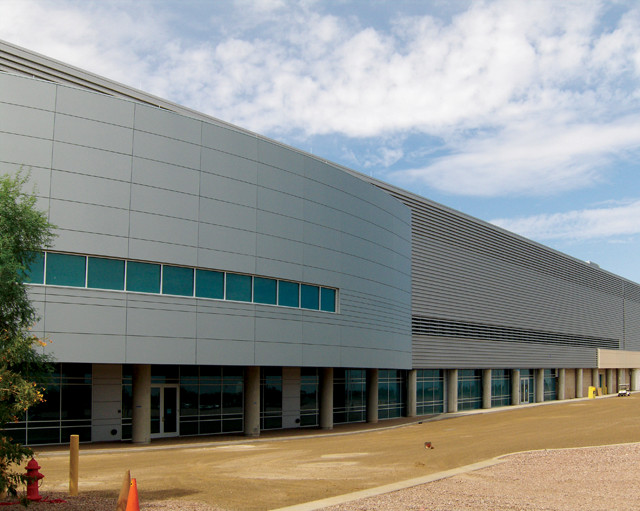
Intel has fabs in water-scarce places such as Chandler, Ariz., where the company built a reverse osmosis plant to clean its manufacturing water. The recycled water then replenishes the city's aquifer. Credit: Intel Corporation.
Some, like Intel — which has plants in China, and in arid places like Arizona and Israel — have worked hard to collaborate with local authorities, Underriner says. Before Intel built its first fab in Chandler, Ariz., a suburb southeast of Phoenix, the company built a reverse osmosis plant to clean its manufacturing wastewater. “We knew we were operating in a desert,” Brady says. “We needed to partner with the local municipality and make sure we were managing water appropriately.” The recycled water is then used to replenish the city’s groundwater aquifer. In Israel, Intel treats wastewater so that it can then be used for agriculture.

The Chimney Rock segment of the Lower Crooked Wild and Scenic River near Prineville, Ore. Although the landscape is dry, the climate allows data centers to use less water. Credit: Bureau of Land Management, Oregon/Washington.
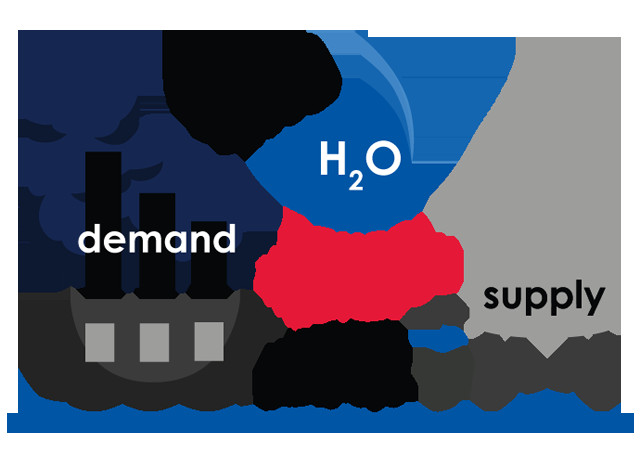
By 2030, water demand will exceed supply by 40%. Credit: K. Cantner/AGI.
Thinking ahead about how to manage water and where to source it when developing a new facility is just good business and eliminates the chance of having to close a plant due to a water shortage in the future, Brady says. “You can very much minimize the risk associated with water shortages in the future, but it requires that up-front planning.”
For companies that haven’t planned ahead, however, the risks could be severe. Operating costs will rise, and communities could grow resentful of thirsty factories in their backyards. But the biggest danger is that a water shortage will interrupt business, Underriner says. According to a 2008 report by JPMorgan Chase & Co., a disruption could force a semiconductor fab to scrap an entire quarter’s worth of product, which would cost a company like Intel or Texas Instruments, another major chip manufacturer, somewhere between $100 million to $200 million per quarter.
Experts say there is still plenty of room for companies to make improvements before it’s too late. Groups like SASB are trying to develop robust metrics to gauge companies’ progress, and others, like CDP, are encouraging them to disclose their practices. Because the implications are clear: “Those that have innovated and developed new business models and new products will win,” Lamb says. Those who are slow to address the issue, or who fail to grasp the scale of the problem, could very well lose.
© 2008-2021. All rights reserved. Any copying, redistribution or retransmission of any of the contents of this service without the expressed written permission of the American Geosciences Institute is expressly prohibited. Click here for all copyright requests.